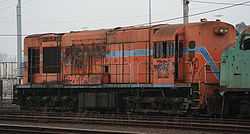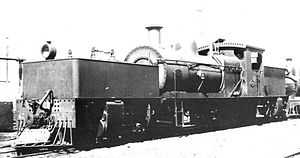WAGR K class (diesel)
| Western Australian Government Railways K class | |
|---|---|
|
K201 at South Dynon Locomotive Depot in June 2006 | |
| Type and origin | |
| Power type | Diesel-electric |
| Builder | English Electric, Rocklea |
| Model | M195C |
| Build date | 1966-69 |
| Total produced | 10 |
| Specifications | |
| AAR wheel arr. | C-C |
| UIC classification | Co-Co, Co′Co′ |
| Gauge | 1,435 mm (4 ft 8 1⁄2 in) standard gauge |
| Length | 16.76 m (55 ft 0 in) |
| Locomotive weight | 122 t (120 long tons; 134 short tons) |
| Fuel type | Diesel |
| Prime mover | English Electric 12CSVT |
| Generator | English Electric 822 |
| Traction motors | English Electric 548 |
| Performance figures | |
| Power output | 1,339 kW (1,796 hp) |
| Career | |
| Operator(s) | Western Australian Government Railways |
| Number in class | 10 |
| Number(s) | K201-K210 |
| First run | January 1966 |
| Current owner |
Greentrains SCT Logistics |
| Disposition | 6 in service, 2 stored, 2 scrapped |
The K class are a class of diesel locomotives built by English Electric, Rocklea for the Western Australian Government Railways between 1966 and 1969.
History

Nine K class were delivered in 1966/67 to operate services on the 657-kilometre (408 mi) Eastern Goldfields Railway from Perth to Kalgoorlie that was being converted to standard gauge. After initially working construction trains, in November 1966 they began working wheat trains from Merredin to Fremantle and once the full line was opened began working services to Kalgoorlie and Esperance.[1]
In January 1966, K201 became the first locomotive to travel across Australia. It hauled freight trains from Brisbane to Melbourne, before being hauled for the rest of the journey. It passed through five states, travelled on six railway systems and required a change of bogies at Melbourne, Port Pirie and Kalgoorlie.[2]
Goldsworthy Mining had purchased six similar locomotives, and after having one destroyed in an accident, purchased K202 with K210 ordered as a replacement. In July 1986 Goldsworth Mining purchased K203.[1]
The Western Australian Government Railways also purchased 16 similar R class locomotives mounted on narrow gauge bogies. In 1974 three were fitted with standard gauge bogies and reclassified as the Ka class.[3]
Four have been sold to SCT Logistics and three had gone to South Spur Rail Services by August 2000.[4][5][6] The latter three are now owned by Greentrains and have been used as Broken Hill shunters as well as in Western Australia.[7][8]
The two sold to Goldsworthy Mining were transferred to BHP's Port Kembla operation in November 1992.[9]
Status list
|
References
- ↑ 1.0 1.1 Oberg, Leon (2010). Locomotives of Australia 1850s-2010s. Kenthurst: Rosenberg Publishing. pp. 340–342. ISBN 9781921719011.
- ↑ "20 Years Ago" Railway Digest January 1986 page 30
- ↑ KA Class (WA, diesel) Railpage
- ↑ "Western Australian Roundup" Railway Digest January 2001 page 40
- ↑ K Class (diesel, WA) Railpage
- ↑ K Class Vicsig
- ↑ K205 Western Australian Railscene e-Mag issue 1 5 January 2009 page 4
- ↑ 8.0 8.1 8.2 K205 Western Australian Railscene e-Mag issue 178 27 February 2012 page 8
- ↑ 9.0 9.1 9.2 Port Kembla - Diesel Locomotive Fleetlisting Light Rail Research Society of Australia
- ↑ K210 Western Australian Railscene e-Mag issue 8 9 February 2009 page 2
- Gunzburg, Adrian (1968). WAGR Locomotives 1940–1968. Perth: Australian Railway Historical Society (Western Australian Division). pp. 44, 50. OCLC 219836193.
- Milne, Rod (1998). Westrail's English Electric Experience (The English Electric locomotives of the WAGR). Elizabeth, SA: Railmac Publications. ISBN 0958650098.
| Wikimedia Commons has media related to WAGR K class (diesel). |
| |||||||||||||||||||||||||||||||||||||


